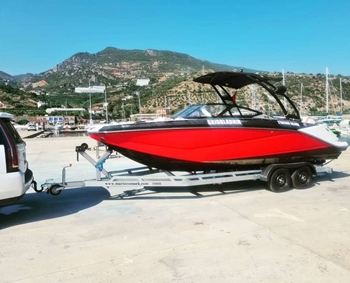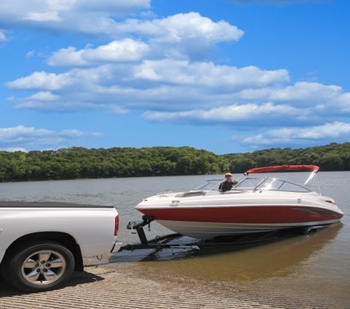Fitting a boat to a trailer may not seem like such a difficult thing to do, but if you never did it before, it quickly becomes a tricky task. If you want everything to go accordingly, you must know the necessary steps to go through. Moreover, you may want to have the proper boat trailer dollies and boat trailer tires as well, so things will go smoothly.
Without further ado, let’s get into how to fit a boat to a trailer.
1. Make Sure You Have the Right Features
 First things first, before you start the process, it’s important to make sure you have the right features. That being said, you need the right ball size for the tow vehicle. That means it should be about 5/16” for tandems that have more than 6,000 load capacity and triple axel trailers, and 2” for small tandems and singles. The capacity has to be greater or at least equal to the boat weight with all tanks full, as well as the trailer weight.
First things first, before you start the process, it’s important to make sure you have the right features. That being said, you need the right ball size for the tow vehicle. That means it should be about 5/16” for tandems that have more than 6,000 load capacity and triple axel trailers, and 2” for small tandems and singles. The capacity has to be greater or at least equal to the boat weight with all tanks full, as well as the trailer weight.
Then, check out whether you have the right electrical connector. Every lead needs to have power when you are using a certain action or light.
2. Take Measurements
Now, you will have to measure your boat to make sure it fits. It has to be measured from the bow eye to the boat’s transom. Basically, the transom has to hang off the end of the bunks by 1-12 inches. That being said, you need to ensure that there is enough distance leading to the bow stop. Then, it has to be moved one foot further forward compared to the first loading.
3. Set Up the Bunks
Loosen the set screws, until the target bunks are on their lowest setting. As for the main bunks, you will not have to move them. The only exception is if they are set at the longitudinal stringer point or stay on a hull transducer or water pickup. If they are in any of these points, then you should move them to the middle of the trailer. Make sure the bunks are also wide enough for lateral stability.
4. Put the Boat on the Trailer
Next, it’s time to lower the trailer on a very steep ramp. Make sure you do it on the steepest one that is available to you. This will ensure the bunks of the target are sticking out of the water just a little.
In accordance with the target bunks, put the boat on your trailer. In order to hook it up, you need to make sure there is enough winch line released. Now, the winch has to be put in low gear, and that can be achieved if you move the turning handle axle. This will allow the small gear on it to come in contact with the gear found close to the handle. This way, the winch handle can be easily turned. However, you should be careful to not fully winch it. You need around a foot to spare, so make sure you don’t winch it all the way to the bow eye.
5. Pull the Boat Out of the Water
Now, you have to take the boat out of the water. Take it far enough from it to make you able to measure the transom placement, in comparison to the back of the bunk. The transom needs to hang over to 1-12 inches, and for that, you will have to repeat step 4 and 5 until it hangs properly.
6. Take the Boat to Ground
What you should do next is make sure you take the boat to flat ground, where you can start checking how much the tongue weighs. This can be done if you block the tires of the trailer and unhook the ball collector of the trailer. Turn the tongue jack and check the pressure. You need to make sure it’s hard, but still maintains a decent hardness and doesn’t overdo it. Having too much tongue weight is better than not having enough.
7. Move the Bow Stop and Attach the Straps
It’s time to move the bow stop and winch stand back, and up or down. This will allow the yellow bow roller to touch the boat with the bow eye below and behind the bow roller. The transom straps should now be attached. After this, don’t forget to make the winch tighter, and also attach the safety chain to the bow eye.
8. Start Driving
 Now, it’s time to start towing. Drive slowly, below 55 or 50.
Now, it’s time to start towing. Drive slowly, below 55 or 50.
Also, you should know that the weight of the tongue should only be around 7% of the weight amount of the loaded boat and trailer and fuel in gear. Use a 4×4, 4. ft, pile of blocks, and a bathroom scale to find out the tongue’s weight.
9. Last Adjustments
You should make sure that the target bunks are adjusted up snug to the hull. After that, the bolts you’ve adjusted, and the wheel lug nuts should be tightened again after you’ve been towing for about ten miles.
Remember that the trailer should be further up the ramp when you are about to pick up your boat, compared to when you are launching it.
Final Thoughts
Fitting a boat to a trailer is quite challenging if you’re not accustomed to it. But everything in life can be learned. So, knowing the necessary steps to go through will make fitting a boat to your trailer very easy. We hope we were able to help you perform this task and that you will not have difficulties anymore.